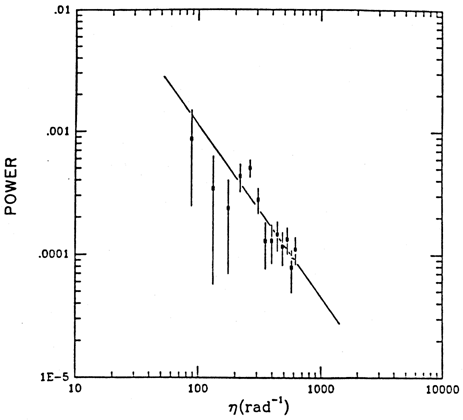Copyright © 1991 by Annual Reviews. All rights reserved
| Annu. Rev. Astron. Astrophys. 1991. 29:
59-88 Copyright © 1991 by Annual Reviews. All rights reserved |
6.2 The Far Ultraviolet Background from Galaxies
Spatial information on very weak far ultraviolet sources was obtained by Martin and Bowyer (1989) with an imaging detector sensitive over the band 1350 to 1900 Å. This detector was flown at the focal plane of a 1 m extreme ultraviolet/far ultraviolet telescope developed as a collaborative effort between Berkeley and Tübingen (Grewing et al. 1983). Data from this imager were subjected to a radial power spectrum analysis in a search for a component of the far ultraviolet background flux which was correlated with angular separation. This search was motivated by the fact that field stars are essentially randomly distributed in angular separation on the sky, whereas galaxies are known to cluster, and the scale of this clustering is well characterized by a two-point correlation function derived from optical data (Peebles 1980). The results obtained by Martin and Bowyer (1989) are shown in Figure 9. Here the observed radial power spectrum of the flux is plotted against angular frequency. The best-fit line to the data is a power law with index -1.6, but given the limited dynamic range of the measurement, this result is not well constrained. The solid line shows a power law with an index of -1.2, which is consistent with the data and is expected from the integrated light of galaxies. Any alternate processes producing this power would not only have to be the result of a spurious unknown effect, but would also have to produce, purely by chance, a power spectrum consistent with that produced by galaxies. One may thus conclude that this component of the far ultraviolet background (~ 50 CU in intensity) is indeed the summed flux of galaxies. The far ultraviolet flux emitted by galaxies contributing to this component of the background is emitted by galaxies in the redshift range from 0.1 to 0.6. This flux is shifted out of the observed far ultraviolet band at distances corresponding to times earlier than the most recent one-third of a Hubble time.

|
| Figure 9. Results obtained by Martin & Bowyer (1989) on the spatial distribution of weak far ultraviolet sources. Here the radial power spectrum of the sources is plotted against angular frequency. Stars contribute a noncorrelated, white noise component to this data. The best-fit line is a power law with index -1.6, but, given the limited dynamic range of the measurement, this result is not well constrained. The solid line shows a power law with an index of -1.2, which is consistent with the data and is what is expected from the integrated light of galaxies. |
Hurwitz, Bowyer, and
Martin (1991)
obtained indirect evidence for an extragalactic component of the far
ultraviolet background from an analysis of the data obtained
with the Berkeley UVX spectrometer. In their analysis of the continuum
emission, they folded a model of the Galactic stellar radiation field
with the observational data and solved for four independent variables:
(a) the albedo of the dust,
(b) the scattering phase function of the dust,
(c) residual dust at NHI = 0,
and (d) an ``external'' flux assumed to be independent
of the Galactic radiation field and to be isotropic
except for attenuation by foreground dust. The results of this analysis
for the albedo and scattering phase function of the dust
were discussed earlier in this review. The ``external'' flux in this analysis
has at least three components. One component is emission at 1550 and
1660 Å, with an intensity consistent with that
reported by
Martin and Bowyer
(1990)
for CIV and OIII] produced in the Galactic halo.
Since the flux is produced well above the plane,
this result provides a consistency check on the analysis.
The second component of ``external'' flux is emission of ~ 120
CU over the entire wavelength band. Diffuse H emission line studies
(Reynolds 1990)
indicate that two-photon emission from a warm ionized medium with a
large-scale height will contribute a continuum
of about 50 CU in the far ultraviolet at high Galactic latitudes,
which will appear in this analysis as an ``external'' flux.
The remaining flux is consistent with the value obtained directly by
Martin and Bowyer
(1989)
as the summed flux of external galaxies.
emission line studies
(Reynolds 1990)
indicate that two-photon emission from a warm ionized medium with a
large-scale height will contribute a continuum
of about 50 CU in the far ultraviolet at high Galactic latitudes,
which will appear in this analysis as an ``external'' flux.
The remaining flux is consistent with the value obtained directly by
Martin and Bowyer
(1989)
as the summed flux of external galaxies.
The intensity of the summed ultraviolet radiation from
galaxies has an important astrophysical consequence.
The observed intensity is consistent only
with a relatively low and constant star formation rate in
galaxies corresponding to
 0.033 M
0.033 M yr-1
Mpc-3 h-2
for the redshift range 0.1 < z < 0.6.
It also limits so-called starburst galaxies to less than
10% of the total population of galaxies in this period.
yr-1
Mpc-3 h-2
for the redshift range 0.1 < z < 0.6.
It also limits so-called starburst galaxies to less than
10% of the total population of galaxies in this period.